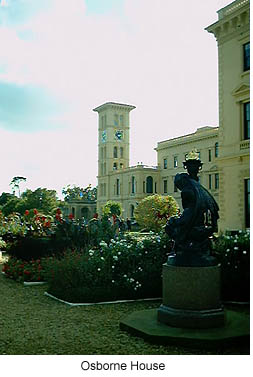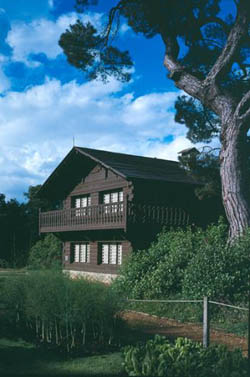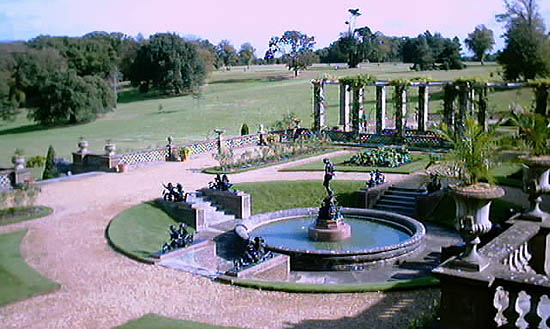Swiss Cottage: A Royal Playhouse
by Tori V. Martínez
 Walk around just about any historical royal retreat and you quickly realize that they were rarely designed with children in mind. It's almost impossible to imagine playful children frolicking among the fragile furnishings and great master paintings in a gilded and marbled royal drawing room, and the usually Spartan nurseries and schoolrooms seem only suitable for the most subdued entertainments. Even the household "play" rooms -- billiard rooms and the like -- were generally the domain of cigar-smoking, brandy-drinking men. Walk around just about any historical royal retreat and you quickly realize that they were rarely designed with children in mind. It's almost impossible to imagine playful children frolicking among the fragile furnishings and great master paintings in a gilded and marbled royal drawing room, and the usually Spartan nurseries and schoolrooms seem only suitable for the most subdued entertainments. Even the household "play" rooms -- billiard rooms and the like -- were generally the domain of cigar-smoking, brandy-drinking men.
Osborne House on the Isle of Wight is no exception, particularly since it was built by none other than Queen Victoria and her consort, Prince Albert, for "quiet and retired" living. As the couple who inspired the ideal of outwardly straight-laced and proper behavior that defined 19th century Victorianism, it's unlikely that Victoria and Albert's nine children were allowed to behave with anything other than absolute decorum within the walls of the beautiful Italianate mansion facing the sea. But even royal Victorian children needed an escape from the adult world, and given that Osborne House was a family retreat from the confines of Court life, it was deemed the perfect place to give the children a retreat of their own.
In 1854, nine years after Victoria and Albert purchased the Osborne estate, the children were presented with just such a place -- Swiss Cottage. Located on the Osborne estate, just far enough way from the main house to make the children feel independent, the so-called "cottage" is no mere backyard tree house. At 25 feet by 50 feet and with two stories, the cottage would be roughly the equivalent of a 2,500 square foot house -- definitely a "royal" playhouse. Surrounding the cottage is the Swiss Cottage Garden, established for the children in 1850, and the nearby thatched summerhouse where the garden tools were kept. All told, it was truly a miniature estate for royal children.
As the name suggests, the cottage was designed in the Swiss style, which was highly popular in the mid-19th century, although the wood used to build it was North American pine. With the exception of the wood, the cottage was built as a fairly true imitation of a Swiss farmhouse, right up to the wrap-around balcony and the rocks on the roof, the latter having been removed in 1932. Inside, the cottage included nearly every possible amenity, albeit on a slightly smaller scale than usual, including a water closet. Fireplaces heated the cottage in winter and the balcony must have been a welcome respite in warmer months. The principal rooms in the cottage included a lobby, a pantry, a functional kitchen, a dining room capable of seating at least 12 guests, and a sitting room. The cottage even had sleeping space, although that was used not by the children, but by the housekeeper, who lived on-site with her husband.
 Like most any childhood retreat, Swiss Cottage was considered the domain of the young princes and princesses, but from the very beginning, the cottage was intended as much for fun as for learning and instruction. Royal though they were, the children were trained to do the basic tasks expected of any average person. The girls were taught to cook and perform household tasks, while the boys were instructed in the ways of carpentry and working the land. All the children were responsible for their own individual portion of the garden and their harvests of flowers, fruits and vegetables were sold -- at market price -- to Prince Albert for use in the royal household. Prince Albert also encouraged the children to pursue his own interest in nature by setting aside space at Swiss Cottage for a collection of natural history objects. As one biographer wrote, "In this little paradise the children did what they liked, but they were shown the best way of doing it." Like most any childhood retreat, Swiss Cottage was considered the domain of the young princes and princesses, but from the very beginning, the cottage was intended as much for fun as for learning and instruction. Royal though they were, the children were trained to do the basic tasks expected of any average person. The girls were taught to cook and perform household tasks, while the boys were instructed in the ways of carpentry and working the land. All the children were responsible for their own individual portion of the garden and their harvests of flowers, fruits and vegetables were sold -- at market price -- to Prince Albert for use in the royal household. Prince Albert also encouraged the children to pursue his own interest in nature by setting aside space at Swiss Cottage for a collection of natural history objects. As one biographer wrote, "In this little paradise the children did what they liked, but they were shown the best way of doing it."
Indeed, some of the work did seem to pay off in play, or at least some personal enjoyment. For the boys, this came in the form of the nearby Victoria Fort and Albert Barracks, which the princes helped to construct in 1856. The miniature mock fortress, which included cannons and a drawbridge, was undoubtedly a favored place of play for the princes, particularly for Prince Arthur, who later became Field Marshal in the British army and Commander-in-Chief in Ireland. For the princesses, the enjoyment they received from their labors appears to have been in the form of the power of choice. In "The Empress Frederick: A Memoir," the story of the life of Queen Victoria's eldest daughter, we're told, "When in their Swiss cottage each princess was allowed to choose her own occupation and to enjoy a certain liberty." In a time when even grown women were considered no better than mere children, this sense of liberty must have been immensely satisfying to the young princesses.
All of the royal children would undoubtedly have enjoyed turning the tables by offering entertainment to their parents, who visited Swiss Cottage often. During these visits, the children could practice and show off their talents as hosts and hostesses and the girls were given the opportunity to test their culinary skills on a captive audience. For her part, Queen Victoria dutifully carried on with the affairs of state while at Swiss Cottage by conducting business at a writing desk in the dining room. For this purpose, and as at any other royal estate, Swiss Cottage even had its own writing paper and silver seal stamped "Swiss Cottage." It's amusing to imagine Queen Victoria writing important correspondence regarding the fate of her kingdom from a small desk in the miniaturized dining room of a children's playhouse.
Today, visitors to Osborne House can still experience this unexpected and unique aspect of historical royal life at Swiss Cottage, which attracts adults and children alike. The exterior of the cottage is restored, but still much as it was in the days of Queen Victoria's children, and the rooms and furnishings inside feel as though the princes and princesses only left a short while ago. The gardens may no longer be tilled by small royal hands, but the collection of natural history objects collected by the children are still on view next door at the Swiss Cottage Museum. Built in 1862 when the collection outgrew the cottage, the collection includes items acquired by the princes and princesses well into adulthood, as well as items collected by their own children.
In many ways, Swiss Cottage doesn't feel like a secondary attraction to Osborne House, which is a delight in itself. The two houses simply represent -- in a very grand way -- the desire of all children to escape from, yet mimic, adult life, and the yearning of adults to return to the simplicity of childhood while still remaining firmly attached to the real world. On the Osborne estate, it was an equation that, for the most part, seemed to work out well. Queen Victoria and Prince Albert both maintained a lifelong love and dedication to Osborne. Queen Victoria continued to find solace there even after the death of Prince Albert, and it was there that she herself died on January 22, 1901. As adults, some of the royal children expressed fond remembrances of their time at Osborne. According the memoir of Empress Frederick:
"Years later, when they had both married, there were certain tunes which neither the Princess Royal nor Princess Alice could hear without tears rising to their eyes, so powerfully did the recollection of the happy birthdays and holidays they spent at Osborne remain with them."
Following Queen Victoria's death, her eldest son and heir, King Edward VII, gifted the Osborne estate to the nation. Land on the estate became the home of a naval college until 1923, but, fortunately, Swiss Cottage and the surrounding buildings were preserved. Osborne House itself became part convalescent home for officers and part public exhibit until gradually more parts of the house were opened to the public.

Today, the entire Osborne estate, located near East Cowes on the Isle of Wight, is worth dedicating an entire day to. Ferries from Southampton leave regularly from Portsmouth, with the car ferry arriving directly at East Cowes and the passenger ferry at West Cowes. An experience in and of itself is the floating bridge that carries both passengers and cars on the short journey from West Cowes to East Cowes.
Osborne House and Gardens is open year-round with varying open days and times depending on the season. For more information, visit the Osborne House portion of the English Heritage web site
More Information:
We regret that we no longer have the resources to maintain up-to-date links and/or hours and pricing details for the various sites and attractions listed on this website. For more information about the location(s) listed above, please use your favorite search engine or visit Wikipedia.
Tori V. Martínez is a writer and freelance public relations professional who spends as much time as possible researching and writing on her favorite subject -- history. Several years ago, Tori eschewed the life of a full-time career woman to travel and live around the world, particularly in Britain, where she spent considerable time exploring and researching historic destinations. At the moment, she is living in the US with her husband -- a Spaniard she met in England -- and is happily writing for a variety of online and print publications.
Article © 2005 Tori V. Martínez
Photo of Swiss Cottage is courtesy of English Heritage (http://www.english-heritage.org.uk) and is copyright English Heritage Photo Library. All other photos are © Tori V. Martínez.
|
